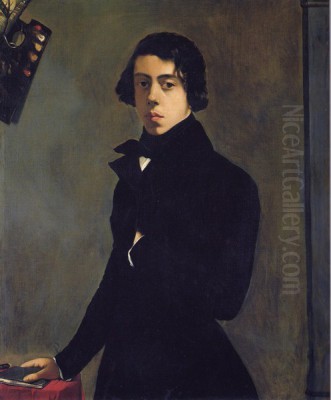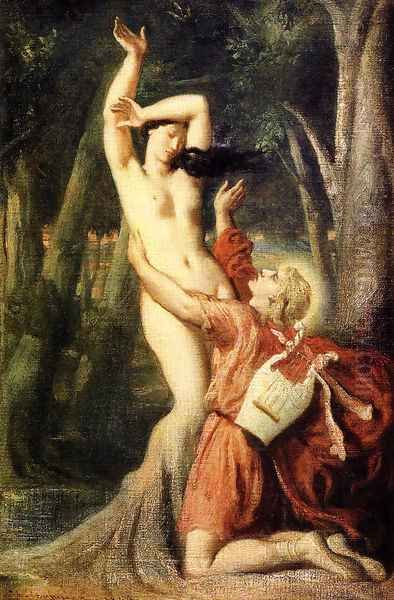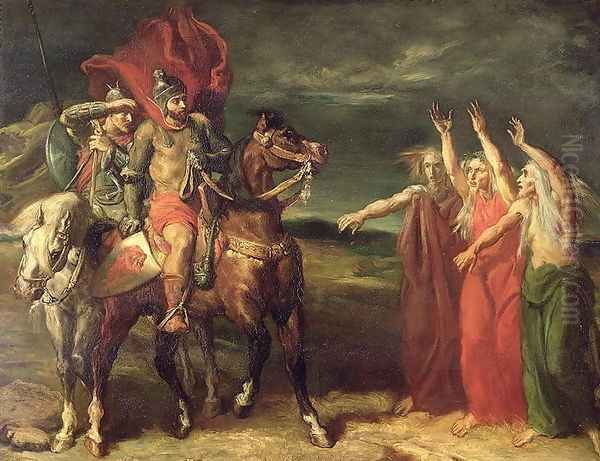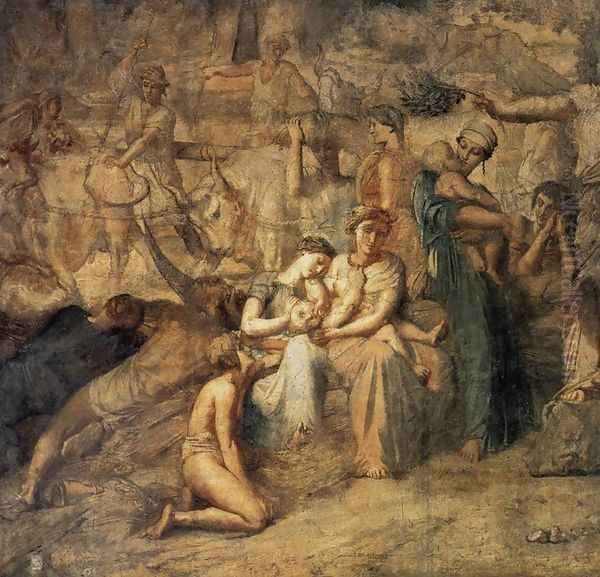
Théodore Chassériau stands as a fascinating and somewhat enigmatic figure in the landscape of 19th-century French art. Living a tragically short life (1819-1856), he nonetheless forged a unique artistic identity, navigating the powerful currents of Neoclassicism and Romanticism. Born in the Caribbean and trained in the heart of Parisian artistic tradition, Chassériau developed a style characterized by lyrical lines, sensuous forms, rich color, and a profound interest in the exotic. His work encompasses grand historical and religious scenes, insightful portraits, influential Orientalist paintings, and ambitious mural cycles, leaving a distinct mark on the art of his time and influencing generations to come.
Early Life and Ingres's Tutelage
Théodore Chassériau was born in El Limón, Samaná, in the Spanish colony of Santo Domingo (now the Dominican Republic). His father, Benoît Chassériau, was a French adventurer who had held administrative positions under Simón Bolívar; his mother, Maria Magdalena Couret de la Blagniére, was the daughter of a Creole landowner. This mixed heritage perhaps prefigured the artist's later fascination with cultures beyond mainland France. The family moved to Paris in 1821, and young Théodore soon displayed exceptional artistic talent.
Recognizing his precocious ability, Chassériau was admitted to the studio of Jean-Auguste-Dominique Ingres in 1830, at the remarkably young age of eleven. Ingres, a towering figure of French Neoclassicism, quickly recognized his pupil's potential. He reportedly declared that Chassériau would become "the Napoleon of painting." Under Ingres's exacting guidance, Chassériau mastered the principles of academic drawing, emphasizing clarity of line, precise form, and idealized beauty derived from classical antiquity and Renaissance masters like Raphael.
Chassériau became one of Ingres's most favored students. His early works, particularly his drawings and portraits, clearly reflect the master's influence. He absorbed Ingres's emphasis on linear elegance and meticulous rendering. This rigorous training provided a solid foundation upon which Chassériau would later build his more personal and complex style. Even as he diverged from Ingres, the discipline and structural understanding gained in these formative years remained evident in his art.
The Pull of Romanticism and the Break with Ingres

While Ingres represented the established order of Neoclassicism, the artistic air in Paris during the 1830s was electric with the energy of Romanticism, championed by Eugène Delacroix. Delacroix's emphasis on color, emotion, dynamic movement, and dramatic subjects stood in stark contrast to Ingres's cool linearity and restraint. The young Chassériau found himself increasingly drawn to the expressive power and vibrant palette of the Romantic movement.
A pivotal moment occurred in 1840 when Chassériau traveled to Rome. Ingres was then serving as the Director of the French Academy in Rome. Chassériau hoped to reconnect with his former master, but the reunion proved disillusioning. Ingres, rigidly adhering to his Neoclassical doctrines, strongly disapproved of the direction Chassériau's art was taking, particularly his growing interest in Delacroix's approach to color and more emotionally charged subjects.
This clash of artistic ideologies led to a definitive break. Ingres, feeling betrayed by his protégé's embrace of Romantic tendencies, essentially disowned him. According to accounts, Ingres lamented Chassériau's perceived defection to the "apostles of ugliness" (referring to the Romantics) and ceased to speak of him. This painful separation forced Chassériau to chart his own course, independent of the master who had shaped his early development. He was now free, albeit perhaps reluctantly, to synthesize the seemingly opposing forces of line and color, classicism and romanticism.
A Unique Synthesis: Blending Line and Color
Freed from the direct orbit of Ingres, Chassériau embarked on developing a highly personal style that sought to reconcile the linear grace of his training with the chromatic richness and emotional depth of Romanticism. He did not simply abandon Ingres's teachings but rather integrated them into a new, more complex vision. His art became a delicate balancing act, retaining a fundamental elegance of form while infusing it with a sensuousness and psychological intensity that was distinctly Romantic.
This synthesis is evident across his diverse body of work. In portraits like The Two Sisters (1843), depicting his sisters Adèle and Aline, the composition retains a classical stability and the rendering of features shows Ingres's influence, yet the mood is imbued with a subtle melancholy and intimacy characteristic of Romantic portraiture. The handling of fabric and the nuanced expressions move beyond purely objective representation.

In his historical and mythological paintings, the Romantic impulse often came to the fore. Works like Apollo and Daphne (1844) or Macbeth and the Three Witches (1855) showcase dynamic compositions, dramatic lighting, and a focus on peak emotional moments. Yet, the figures themselves often retain a sculptural quality and clarity of contour that betray his Neoclassical grounding. He aimed for an art that was both intellectually structured and emotionally resonant.
The Lure of the Orient: The Algerian Journey
Like Delacroix before him, Chassériau was captivated by the allure of the "Orient"—a term then used broadly to encompass North Africa and the Middle East. This fascination culminated in a pivotal journey to Algeria in 1846. He spent several months there, traveling extensively and immersing himself in the local culture. The experience had a profound and lasting impact on his art.
Chassériau was enthralled by the light, colors, customs, and people he encountered. He filled numerous notebooks with sketches—over a thousand drawings are documented—capturing everything from street scenes and landscapes to portraits of local figures and details of traditional attire. These sketches served as a rich source of inspiration for paintings he would create upon his return to Paris and for the remainder of his career.
His Algerian works are among his most celebrated. Paintings such as Ali-Ben-Hamet, Caliph of Constantine, Followed by his Escort (1845, though likely finished after the trip based on sketches) and Scene in the Jewish Quarter of Constantine (c. 1851) demonstrate his keen observation and his ability to convey the atmosphere of North Africa. Unlike some Orientalist painters who focused merely on exotic spectacle, Chassériau often imbued his scenes with a sense of dignity and ethnographic interest, though still filtered through a Romantic lens. His depictions of Algerian women, such as Jewish Women on a Balcony (1849), are particularly noted for their sensuousness and quiet introspection. His Orientalism, while sharing themes with artists like Delacroix or later Jean-Léon Gérôme, possessed its own distinct blend of realism and poetic idealization.
Major Commissions and Public Works
Despite his relatively short career, Chassériau secured several important public commissions, demonstrating the recognition he achieved within the official art establishment, even as he navigated his independent path. One of his earliest successes came at the Paris Salon of 1836, where, at the age of just 17, he won a third-class medal for his painting Cain Maudit (Cain Accursed).

His most ambitious undertaking was the decoration of the grand staircase of the Cour des Comptes (Court of Accounts), housed in the Palais d'Orsay (which was later destroyed by fire during the Paris Commune in 1871). Commissioned in 1844 and completed in 1848, this monumental cycle included allegorical figures representing Peace and War, as well as scenes related to commerce and administration. Surviving fragments, preparatory studies, and contemporary descriptions indicate a powerful synthesis of classical structure and Romantic energy, perfectly suited to the grand scale of mural painting. The loss of these murals is considered a major tragedy in 19th-century French art.
Chassériau also undertook decorative work for churches, such as Saint-Merri and Saint-Roch in Paris, although some of these projects faced difficulties or remain less well-documented than the Cour des Comptes cycle. Another significant project was a series of fifteen etchings illustrating Shakespeare's Othello, published in 1844. These prints showcase his dramatic flair and his ability to translate literary emotion into visual form, particularly in scenes like Desdemona Retiring to her Bed.
Master of Diverse Genres
Chassériau excelled across a remarkable range of genres, demonstrating his versatility and the adaptability of his unique style.
Portraits: Beyond the celebrated Two Sisters, Chassériau was a sought-after portraitist. His Portrait of Alexis de Tocqueville (1850), the famous political thinker and historian, captures the sitter's intellectual intensity with remarkable acuity. His portrait of the Orientalist painter Prosper Marilhat (1841) conveys a sense of camaraderie and shared artistic interests. Chassériau's portraits are noted for combining Ingres-like precision in the rendering of the face with a more Romantic sensitivity to mood and psychological depth.
Historical and Religious Scenes: Chassériau continued to engage with traditional grand genres throughout his career. Le Tepidarium (1853), depicting women lounging in the warm room of Roman baths inspired by his visit to Pompeii, is one of his most famous works. It combines archaeological interest with a sensuous depiction of the female nude, blending classical themes with Romantic atmosphere. Religious works like Christ in the Garden of Olives (c. 1840) or Susanna and the Elders (1839) allowed him to explore dramatic narratives and complex figure compositions.
Mythological Subjects: Classical mythology provided another avenue for exploring idealized forms and dramatic storytelling. Venus Anadyomene (1838) is an early example showing his debt to Ingres but already hinting at a warmer, more sensuous treatment. Later works like Apollo and Daphne (1844) are more dynamic and emotionally charged, fully embracing his mature style.
Literary Illustrations: The Othello series stands out, but Chassériau also drew inspiration from other literary sources. His ability to capture the essence of a dramatic text visually was highly regarded. Works like Desdemona (The Willow Song) demonstrate his capacity for conveying pathos and narrative tension through composition and expression.
Contemporaries and Context

Chassériau worked during a vibrant and transformative period in French art. His career unfolded against the backdrop of the ongoing rivalry between Ingres's Neoclassicism and Delacroix's Romanticism. He stands out precisely because he attempted to bridge this divide, drawing admiration and criticism from both camps.
His contemporaries included a diverse array of artists. Besides Ingres and Delacroix, key figures were Paul Delaroche, known for his historical genre paintings that blended academic finish with Romantic drama; Thomas Couture, whose Romans of the Decadence (1847) represented the juste milieu (middle ground) approach; and the emerging Realists like Gustave Courbet and Jean-François Millet, who were challenging both Neoclassicism and Romanticism with their focus on contemporary life and unidealized subjects.
Other notable artists of the era included the landscape painters of the Barbizon School, such as Camille Corot, who brought a new naturalism to landscape painting, and Honoré Daumier, a powerful social commentator through his paintings and lithographs. Jean-Léon Gérôme would become a prominent academic painter, known especially for his highly detailed Orientalist and historical scenes, offering a different take on themes Chassériau explored. While perhaps influenced by earlier Rococo masters like Jean-Honoré Fragonard in terms of sensuousness, Chassériau's core dialogue was firmly rooted in the Ingres-Delacroix debate of his own time.
Legacy and Influence
Despite dying prematurely at the age of 37 from a debilitating illness, Théodore Chassériau left a significant legacy. His attempt to synthesize the linear purity of Neoclassicism with the color and passion of Romanticism resulted in a body of work that remains distinctive and compelling. He demonstrated that these seemingly opposing artistic forces could coexist and enrich one another.
His influence extended to the next generation of artists. He was particularly important for Gustave Moreau, who deeply admired Chassériau and whose own mystical and symbolist art owes a debt to Chassériau's imaginative compositions and rich surfaces. Pierre Puvis de Chavannes, a major figure in later 19th-century mural painting, also looked to Chassériau's example, particularly his work at the Cour des Comptes, for its blend of classical order and poetic feeling. Through Moreau, Chassériau's influence indirectly touched upon the Symbolist movement.

Art historians regard Chassériau as a pivotal figure, albeit one whose full potential may have been unrealized due to his early death. He was an artist of exceptional talent and sensitivity, capable of great tenderness in his portraits, dramatic power in his historical scenes, and evocative beauty in his Orientalist works. While perhaps not achieving the towering fame of Ingres or Delacroix during his lifetime or immediately after, his reputation has grown steadily, and he is now recognized as one of the most original and appealing artists of the French Romantic era.
Conclusion
Théodore Chassériau's art offers a unique window into the complexities of 19th-century French painting. Trained by the arch-Neoclassicist Ingres, yet irresistibly drawn to the Romanticism of Delacroix, he forged a path between these two giants. His work is characterized by an exquisite balance of line and color, classical form and romantic emotion. From the intimate portraits of his sisters to the vibrant scenes of Algerian life, from the tragic figures of Shakespeare to the monumental allegories of his public murals, Chassériau's art resonates with a distinctive poetic sensibility. His tragically short life cut short a brilliant career, yet the works he left behind secure his place as a crucial and captivating figure in the history of art, a master whose eclectic vision continues to fascinate and inspire.